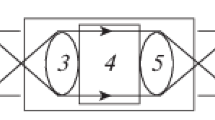Summary
Colloidal gold complexes with protein A are extensively used in immunocytochemistry as secondary reagents for the localization of antigens. However detailed information on the process and extent of adsorption of protein A onto gold particles, the optimal condition of preparation and the stability of such complexes are lacking. The adsorption isotherm of 125I-protein A onto gold particles (11.2 nm in diameter) was studied quantitatively with gold sols buffered at pH 4–7. At low coverage of the particles, the isotherm was independent of pH. However in the presence of a large excess of protein A, the highest coverage was obtained with a gold sol buffered at pH 5.1, the isoelectric point of the protein. The association constant was decreased at high coverage of the particles. Maximum binding of the complex to immobilized IgG occurred with particles labelled with at least 9 molecules of protein A. The complex was stable under storage with up to 12 molecules adsorbed per particle. At high coverage (26 molecules per particle), a progressive loss of protein A was observed. The optimum condition for preparing the complex are reported.
Similar content being viewed by others
References
Bendayan M (1984) Protein A-gold electron microscopic immunocytochemistry: methods, applications, and limitations. J Electron Microsc Techn 1:243–270
Björk I, Petersson BA, Sjöquist J (1972) Some physicochemical properties of protein A from Staphylococcus aureus. Eur J Biochem 29:579–584
Eirich FR (1977) The conformational states of macromolecules adsorbed at solid-liquid interfaces. J Colloid Interface Sci 58:423–436
Fontana J (1971) Adsorption of biological analog molecules on nonbiological surfaces. Polymers. In: Hair ML (ed) Chemistry of biosurfaces. Marcel Dekker, New York, pp 83–142
Forsgren A (1970) Significance of protein A production by Staphylococci. Infect Immun 2:672–673
Forsgren A, Sjöquist J (1966) “Protein A“ from S. aureus. I. Pseudo-immune reaction with human γ-globulin. J Immunol 97:822–827
Geoghegan WD, Ackerman GA (1977) Adsorption of horseradish peroxidase, ovomucoid and anti-immunoglobulin to colloidal gold for the indirect detection of concanavalin A, wheat germ agglutinin and goat anti-human immunoglobulin G on cell surfaces at the electron microscopic level: a new method, theory and application. J Histochem Cytochem 25:1187–1200
Goodman SL, Hodges GM, Trejdosiewicz LK, Livingston DC (1981) Colloidal gold markers and probes for routine application in microscopy. J Microscopy 123:201–213
Goudswaard J, Van der Donk JA, Noordzij A, Van Dam RH, Vaerman JP (1978) Protein A reactivity of various mammalian immunoglobulins. Scand J Immunol 8:21–28
Heller W, Pugh TL (1960) “Steric” stabilization of colloidal solutions by adsorption of flexible macromolecules. J Polymer Sci 47:203–217
Horisberger M (1979) Evaluation of colloidal gold as a cytochemical marker for transmission and scanning electron microscopy. Biol Cell 36:253–258
Horisberger M (1981) Colloidal gold: a cytochemical marker for light and fluorescent microscopy and for transmission and scanning electron microscopy. In: Johari O (ed) Scanning electron microscopy, vol 2. SEM Inc., AMF O'Hare, Chicago, pp 9–31
Horisberger M, Tacchini-Vonlanthen M (1983) Ultrastructural localization of Kunitz inhibor on thin sections of Glycine max (soybean) cv. Maple Arrow by the gold method. Histochemistry 77:37–50
Horisberger M, Vauthey M (1984) Labelling of colloidal gold with protein. A quantitative study using β-lactoglobulin. Histochemistry 80:13–18
Langone JJ (1978) [125I] Protein A: a tracer for general use in immunoassay. J Immunol Methods 24:269–285
Langone JJ (1982) Protein A of Staphylococcus aureus and related immunoglobulin receptors produced by streptococci and pneumococci. Adv Immunol 32:157–252
Roth J (1982) The protein A-gold (pAg) technique — a qualitative and quantitative approach for antigen localization on thin sections. In: Bullock GR, Petrusz P (eds) Techniques in immunocytochemistry, vol 1. Academic Press, London New York, pp 107–132
Sjöholm I (1975) Protein A from Staphlococcus aureus. Spectropolarimetric and spectrophotometric studies. Eur J Biochem 51:55–61
Tinglu G, Ghosh A, Ghosh BK (1984) Subcellular localization of alcaline phosphatase in Bacillus licheniformis 749/C by immunoelectron microscopy with colloidal gold. J Bacteriol 159:668–677
Tokuyasu KT (1983) Present state of immunocryoultramicrotomy. J Histochem Cytochem 31:164–167
Verwey EJW, Overbeek JTG (1948) Theory of the stability of lyophobic colloids. Elsevier, Amsterdam
Author information
Authors and Affiliations
Rights and permissions
About this article
Cite this article
Horisberger, M., Clerc, M.F. Labelling of colloidal gold with protein A. Histochemistry 82, 219–223 (1985). https://doi.org/10.1007/BF00501398
Accepted:
Issue Date:
DOI: https://doi.org/10.1007/BF00501398




